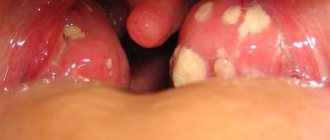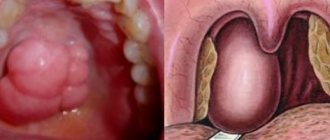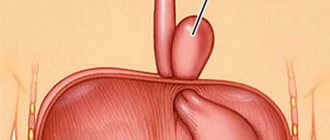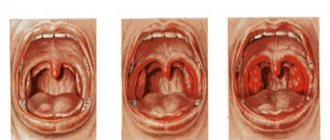Throat ulcers - causes and treatment methods
Throat ulcers are formed as a result of damage to the mucous membrane of the pharynx, larynx or pharynx. They can be caused by different reasons. Some sores require special equipment to identify, and some are visible to the naked eye.
Effective treatment requires the help of a qualified specialist who will conduct a thorough diagnosis and, based on its results, prescribe treatment.
Why do ulcers form on the mucous membrane of the throat?
Ulcers in the throat can have different causes, but in any case they indicate some kind of disease or trouble. Most often, purulent tonsillitis leads to the formation of ulcers on the throat mucosa.
In addition to diseases, such damage to the mucous membrane can be caused by excessive tension in the ligaments in people whose profession involves heavy load. These are teachers, singers, and hosts of public events.
In addition, the cause of the formation of ulcers can be an adverse effect on the mucous membrane of the throat, a decrease in immunity that occurs for various reasons.
Causes of sores in the throat
- Infectious diseases of the throat,
- Gastrointestinal diseases,
- Irritants such as citrus juice, tobacco smoke,
- Vitamin deficiency
- Allergic reactions,
- Diseases of the oral mucosa,
- Failure to comply with personal hygiene rules,
- State of immunodeficiency,
- Changes in hormonal levels,
- Stress,
- Tumors in the throat area.
What are the types of throat ulcers?
Most often, there are two types of ulcers: contact and superficial. Contact ulcers are formed mainly in the larynx due to overstrain of the ligaments. Also, the cause of contact throat ulcers can be reflux esophagitis due to irritation of the mucous membranes of the throat by the contents of the stomach. Damage may occur due to persistent coughing in heavy smokers.
The peculiarity of contact ulcers is that they are located deep in the throat, and only a specialist can see them using special equipment.
Superficial white or red sores in the throat can be a symptom of various diseases and conditions. Red sores are lesions of the mucous membrane of the throat, which do not contain purulent formations. Most often these are the consequences of irritants or vitamin deficiency.
White ulcers in the throat are formed with aphthous stomatitis or herpetic sore throat. Ulcerative necrotic tonsillitis leads to the formation of ulcers with a dirty gray bottom on the surface of the tonsils.
Thus, based on the location, localization and nature of damage to the mucous membranes of the throat, the doctor can guess their cause, which is important for choosing the right treatment tactics. For example, ulcers on the back of the throat most likely indicate advanced pharyngitis.
Symptoms and manifestations
When ulcers form on the mucous membranes, there will inevitably be unpleasant manifestations. Parents of young children should be especially attentive, because they cannot yet complain about their well-being.
Here it is important to consult a doctor in time for help, however, there are cases when white ulcers in a child’s throat are mistaken for ordinary plaque formed from particles of dairy products that the baby has recently eaten.
The external picture may resemble symptoms of purulent tonsillitis or stomatitis.
Symptoms of diseases in which ulcers form in the throat
- Red, white, or yellowish lesions on the tonsils,
- Redness of the throat mucosa,
- A sore throat,
- Dry throat and mouth,
- Deterioration of general condition,
- Temperature increase.
Throat ulcers in a child can cause severe pain, which leads to refusal to eat. In very young children this may be the only manifestation of the disease.
Therefore, you should be wary if the baby is capricious and has completely stopped eating.
There may also be other manifestations, which depend on the cause of damage to the mucosa. In any case, even if there are no other symptoms other than ulcers that have formed, you should consult a doctor to make a diagnosis and prescribe appropriate measures.
Diagnostics
If you find ulcers in the throat, you need to contact an otolaryngologist or a therapist; if this is a child, then a pediatrician. The doctor will prescribe the necessary tests that will help make an accurate diagnosis.
Diagnostic measures
- Anamnesis collection,
- Detailed inspection
- Laryngoscopy,
- Endoscopy.
With the help of these studies, the localization and nature of the ulcers are revealed.
Laryngoscopy is performed using a special instrument and allows you to examine in detail the mucous membranes of the entire throat. Endoscopy can be used to examine deeper parts.
In some cases, additional diagnostic measures may be needed.
Additional Research
- Abscess puncture,
- Biopsy of ulcer tissue,
- Ultrasound, CT, X-ray of the neck.
The results of these studies will show the nature of the contents of the abscesses, if any, and the degree of danger in the presence of tumors in the throat.
Treatment
Treatment for a throat ulcer depends on its cause. If it is an infection, then most likely after it is eliminated, the mucous membrane of the throat will return to normal. You may need to take some local measures to speed up healing.
Treatment options
- Medication,
- Rinse,
- Dieting
- Surgery in severe cases.
Drug treatment is prescribed according to the diagnosis. Antibiotics, antivirals, analgesics, antiseptics or antihistamines may be needed.
Gargling and mouthwash are prescribed for any diagnosis. They will help localize and minimize the infection and speed up healing. This procedure should be carried out after each meal and in between. A good antiseptic effect is achieved by rinsing with solutions of Chlorhexidine, Furacilin; decoctions of sage and chamomile promote rapid healing.
Correction of nutrition is important when ulcers form in the throat. Food should not be rough, spicy, or sour, so as not to irritate the mucous membranes and further injure them.
In severe cases, surgical intervention may be necessary, which is prescribed according to indications. If ulcers appear in the throat, you should not expect them to go away on their own. They can be evidence of serious problems or a source of infection, so treatment should be started as soon as possible.
Source: https://med-gorlo.ru/bolezni/yazvy-v-gorle-prichiny-poyavleniya-i-metody-lecheniya.html
Reasons for appearance
Determining the causes of such formations is a very important part of treatment. It is impossible to overcome symptoms if the source of the pathology is unknown.
Ulcerative necrotic tonsillitis
This disease is rare. Otherwise it is called Simanovsky-Vincent's angina.
Its main feature is the formation of ulceration with a dirty gray color on one of the tonsils (see photo). The pathology is caused by two bacteria - Vincent's bacillus and the common spirochete.
These microorganisms are classified as opportunistic because they are present in the microflora of a healthy person and this does not harm him in any way.
The disease begins to develop only in the presence of factors favorable to it, in which the bacteria are activated.
This may happen due to the following circumstances:
- lack of vitamins;
- weakened immunity;
- physical fatigue;
- insufficient protein intake;
- chronic diseases of autoimmune origin;
- infectious diseases of the oral cavity and teeth.
Necrotizing ulcerative tonsillitis usually affects only one tonsil. This is manifested by intensive organ growth, redness, the formation of a gray-yellow coating and an unpleasant odor.
In addition, negative symptoms such as:
- discomfort in the throat;
- difficulty swallowing;
- enlarged lymph nodes;
- increased salivation;
- stomatitis.
Despite the fact that the tonsils are severely damaged in this disease, the patient’s overall health is satisfactory. The risks increase significantly when a streptococcal or staphylococcal infection is added.
Herpangina
Herpangina occurs due to exposure to the Coxsackie virus. As a result, multiple small white sores appear. They can be located on the tonsils, uvula, or back of the pharynx. At first these formations look like small blisters, but then turn into ulcers.
Apart from ulcerations, the patient may notice the following symptoms;
- sore throat;
- hyperthermia;
- difficulty swallowing;
- swollen lymph nodes;
- general deterioration of health;
- nausea;
- stomach ache.
Video from Dr. Komarovsky:
Most often, herpetic sore throat is found in a child, but it can also affect an adult.
Aphthous stomatitis
This pathology is so called because it is characterized not only by the inflammatory process usual for stomatitis, but also by the formation of aphthae.
Aphthae are small ulcers with a gray-yellow surface color (see photo). They can occur singly, but multiple formations can also occur.
The exact causes of the development of aphthous stomatitis have not yet been identified.
It is provoked by various factors, which often act in combination with each other.
These include allergies, infections, gastrointestinal disorders, etc.
In addition to the appearance of ulcers on the mucous membranes, this disease can be identified by the following symptoms:
- elevated temperature;
- pain in the affected area;
- increased salivation;
- discomfort while chewing;
- lymphadenitis.
The disease is not considered dangerous and can be quickly cured. Complications can occur due to improper therapy or its absence.
Contact ulcer of the larynx
The occurrence of this problem is usually caused by frequent overstrain of the vocal cords and throat.
This happens if a person has to talk a lot, which is typical for representatives of some professions.
Also, contact ulcers of the larynx are formed due to strong irritating effects on the mucous membranes of this area.
A chronic cough typical of a smoker or someone with a cold can irritate the throat.
Such ulcers form deep in the pharynx and larynx. They cannot be detected without special tools.
Their presence can be guessed by the accompanying symptoms, which include such features as:
- hoarse voice;
- pain when the vocal cords are tense;
- difficulties while swallowing.
There are usually no other signs of pathology. Only with significant progression of the unfavorable process, when inflammation develops to a significant extent, can the temperature rise and symptoms of intoxication appear.
The listed features can also be detected in the presence of malignant tumors in the throat. Therefore, if you experience such symptoms, you should consult a doctor immediately.
Chemical or radiation damage
Throat ulcers can occur due to damage to the throat from harsh chemicals. People may use them by mistake, but such carelessness can result in chemical burns.
The presence of chemical damage to the larynx may be indicated by severe pain in this area. The patient also has a red throat.
Ulceration also occurs when this area is frequently exposed to radiation. If a person is employed in an area where UV rays or radiating elements are frequently used, the risk of developing ulcers increases.
Throat cancer
This disease is the most dangerous because it threatens the patient’s life. Therefore, it is very important to contact specialists when ulcers appear in this area - to make sure that the problem is not related to oncology.
Often, the formation of cancerous ulcerations is preceded by leukoplakia, in which gray spots appear on the mucous membranes. They occur for various reasons, but very often they are caused by smoking. In the future, these spots can degenerate into a malignant tumor, resulting in the formation of ulcers.
Sores in the throat: symptoms, diagnosis, treatment - Gorlonos.ru
Sores in the throat cause a lot of discomfort.
Formations can be located in visually accessible areas, but in some cases such manifestations can only be detected with the help of special mirrors.
The term “ulcer” means significant damage to the mucous membrane of the throat, characterized by inflammatory processes: swelling, hyperemia, and the appearance of a whitish coating are observed.
The formation of ulcers in the throat is a significant damage to the mucous membrane of the throat, characterized by inflammatory processes
Causes of the phenomenon
Medicine clearly distinguishes between the concepts of “wound” and “ulcer”. In the first case, damage occurs to living tissues capable of regeneration, and in the second, the fibers become necrotic, the healing process remains lengthy, systemic and multicomponent treatment is required, and after the defect disappears, scars often remain.
The causes of such ulcers on the throat are considered to be:
- Viruses or bacteria, re-infection after acute respiratory viral infections.
- Chemical burns, traumatic damage to the shell.
- Impaired capillary circulation, as a result of which the nutrition of epithelial cells becomes insufficient.
- Stomach diseases that provoke a constant release of acidic substances into the throat.
- Oncological diseases of various kinds that disrupt metabolic processes.
- Allergies, hormonal changes in the body, vitamin deficiency, lack of essential microelements.
The causes of sores on the throat are considered to be: viruses, impaired capillary circulation, vitamin deficiency and lack of essential microelements.
White sores in the throat may appear on the tonsils. They signal serious illnesses, such as:
- Gangrenous tonsillitis. The formations cover not only the tonsils, but also the oral cavity, reminiscent of manifestations of stomatitis.
- Sore throats caused by viruses or bacteria first give a sharp inflammatory reaction. If the disease occurs in a complicated form, then purulent plugs appear and ulcers form in the lacunae.
- Advanced types of tonsillitis can provoke the appearance of erosions throughout the oral cavity and on the pharyngeal mucosa.
- Diphtheria form of sore throat. The accumulation of necrotic formations is clearly visible on the surface of the tonsils.
Such violations are especially dangerous against the background of reduced immunity. The body does not suppress pathogenic microflora; weak phagocytosis becomes one of the causes of inflammation and damage to pharyngeal tissue. Sometimes ulcers are formed when fungal flora is activated.
Types of ulcers, their symptoms
Otolaryngologists distinguish several types of ulcers. Common:
- Leukoplakia. Such a sore is a thick whitish, pinkish or gray formation, they are characterized by proliferation and keratinization of epithelial tissues. According to statistics, in 3% of untreated cases, cells degenerate, mutate and a cancerous tumor is formed.
- Papillomas are close to leukoplakia, remain benign formations, and often do not differ in color from the surrounding tissues, but may have a redder color. They are located on the soft palate and cover the lateral walls of the pharynx. They manifest themselves as a feeling of discomfort, hoarseness or somewhat difficult passage of air.
- Mycotic, stomatitis manifestations. The candida fungus, when multiplying, damages the delicate and loose surface fibers covering the throat. Visually, the spots resemble small white rashes, erosions, and small intercellular hemorrhages that secrete a cheesy substrate.
The first and second types are more common, in almost 80% of patients who consult specialized specialists.
A special type is considered to be ulcers in the throat that appear as a result of prolonged overstrain of the ligaments against the background of incipient inflammatory processes. Ulcers in a child’s throat may be the initial stage of aphthous stomatitis.
The symptoms of the disease are varied, so patients do not always consult a doctor on time. Doctors urge you to visit the clinic if you have experienced:
- Sore throat without significant deterioration in well-being.
- Inexplicable discomfort in the throat, manifested in causeless burning, tingling, and itching.
- Visually noticeable inflammation of the mucous membrane on the tonsils and in the initial part of the pharynx.
- I was overcome by a constant dry throat.
- Snoring appears, and at night there are unpleasant sensations in the nasopharynx.
- Children complain of scratching in the nasopharynx.
Otolaryngologists distinguish several types of ulcers: leukoplakia, papillomas close to leukoplakia, mycotic, stomatitis manifestations.
More severe symptoms are also possible: obvious pain, visually noticeable erosions, weakness, hearing problems, and sometimes the disease is accompanied by mild conjunctivitis. Patients usually try to cope with the first signs of the disease on their own, but doctors recommend contacting an otolaryngologist if the symptoms do not disappear within 3-4 days.
Diagnosis and treatment of ulcers on the throat mucosa
With the help of correct diagnosis, the doctor will determine the severity of the disease, identify the cause of the ulcers or specify the type of causative agent of the disease. Only after a thorough analysis of all factors will appropriate treatment be prescribed.
The simplest method of examination remains laryngoscopy. The larynx is examined using a system of mirrors and lighting. Referrals are issued for several types of clinical studies: a general blood test and a throat smear are required.
In recent years, the use of an endoscope, a special device with a camera on a flexible guide, has become popular. The image is displayed on a special screen, pathological processes can be examined in detail.
Taking a puncture - purulent exudate from erosion - will determine the nature of the disease. A biopsy will reveal changes of an oncological nature. Sometimes they are prescribed according to ultrasound and CT indications.
The otolaryngologist will tell you how to treat each type of ulcer after receiving the examination results. The general scheme of using different drugs is similar to the treatment of tonsillitis:
- Gargling is effective as an antiseptic treatment. Solutions based on diluted furatsilin, chlohexedine, Tantum Verde are suitable. Decoctions of chamomile and coltsfoot are used. A few drops of essential oil per glass of water perfectly disinfect the lining of the nasopharynx: you can use tea tree extract, sea buckthorn extract.
- Lollipops, lozenges, and sprays will relieve inflammation, reduce pain, and increase healing. Isla, anzibel, chlorophyllipt in the form of tablets or aerosols, ingalipt, angilex will help eliminate pathogenic microflora on the surface of ulcers and growths.
- If the causative agent is a virus, then antiviral drugs are prescribed: arbidol, amizon, acyclovir. In case of bacterial form, antibiotics of the penicillin group or macrolides will be effective. Bioparox spray is also used, which acts directly on the affected areas of the mucous membrane.
- If the patient is faced with a fungal form of the disease, then antifungal drugs are prescribed: ketoconazole, mycozoral, natamycin.
- You will need to treat the sore in the throat with a swab soaked in an antiseptic solution: you can use Lugol, oil chlorophyllipt. In this way, erosion is cleared of plaque and the regeneration of healthy cells is promoted.
With proper diagnosis, the doctor will determine the severity of the disease. The simplest method of examination remains laryngoscopy.
To reduce swelling and relieve possible allergic reactions, the attending doctor will prescribe an antihistamine: aleron, loratadine or another analogue. In the normal course of the disease, conservative therapy is sufficient; only 3-5% of cases will require surgical intervention.
Why do sores form in the throat, how to treat them Link to main publication
Source: https://gorlonos.ru/throat/simptomy/yazvochki-v-gorle.html
Diagnosis and treatment of ulcers on the throat mucosa
With the help of correct diagnosis, the doctor will determine the severity of the disease, identify the cause of the ulcers or specify the type of causative agent of the disease. Only after a thorough analysis of all factors will appropriate treatment be prescribed.
The simplest method of examination remains laryngoscopy. The larynx is examined using a system of mirrors and lighting. Referrals are issued for several types of clinical studies: a general blood test and a throat smear are required.
In recent years, the use of an endoscope, a special device with a camera on a flexible guide, has become popular. The image is displayed on a special screen, pathological processes can be examined in detail.
Taking a puncture - purulent exudate from erosion - will determine the nature of the disease. A biopsy will reveal changes of an oncological nature. Sometimes they are prescribed according to ultrasound and CT indications.
The otolaryngologist will tell you how to treat each type of ulcer after receiving the examination results. The general scheme of using different drugs is similar to the treatment of tonsillitis:
- Gargling is effective as an antiseptic treatment. Solutions based on diluted furatsilin, chlohexedine, Tantum Verde are suitable. Decoctions of chamomile and coltsfoot are used. A few drops of essential oil per glass of water perfectly disinfect the lining of the nasopharynx: you can use tea tree extract, sea buckthorn extract.
- Lollipops, lozenges, and sprays will relieve inflammation, reduce pain, and increase healing. Isla, anzibel, chlorophyllipt in the form of tablets or aerosols, ingalipt, angilex will help eliminate pathogenic microflora on the surface of ulcers and growths.
- If the causative agent is a virus, then antiviral drugs are prescribed: arbidol, amizon, acyclovir. In case of bacterial form, antibiotics of the penicillin group or macrolides will be effective. Bioparox spray is also used, which acts directly on the affected areas of the mucous membrane.
- If the patient is faced with a fungal form of the disease, then antifungal drugs are prescribed: ketoconazole, mycozoral, natamycin.
- You will need to treat the sore in the throat with a swab soaked in an antiseptic solution: you can use Lugol, oil chlorophyllipt. In this way, erosion is cleared of plaque and the regeneration of healthy cells is promoted.
With proper diagnosis, the doctor will determine the severity of the disease.
The simplest method of examination remains laryngoscopy. To reduce swelling and relieve possible allergic reactions, the attending doctor will prescribe an antihistamine: aleron, loratadine or another analogue. In the normal course of the disease, conservative therapy is sufficient; only 3-5% of cases will require surgical intervention.
Ulcers on the throat: in children and adults. Treatment at home
If red or whitish ulcers appear in the throat of a child or adult, it means that there are problems in the body.
Symptoms can be provoked by infectious diseases, tumors, damage to the mucous membrane, overload of ligaments and other factors.
To identify the true cause of erosive lesions of the larynx, you should visit a doctor. He will determine the nature of the pathology, select an appropriate treatment regimen and give recommendations for therapy at home.
Bloody and purulent wounds on the surface of the larynx signal existing health problems. In most cases, rashes appear due to viral and bacterial infections - pharyngitis, tonsillitis (tonsillitis), laryngitis, stomatitis.
Injuries resulting from burns or regular overstrain of ligaments also lead to tissue damage. This problem is typical for teachers, singers, and event hosts.
Often the throat suffers from smokers and alcohol drinkers - the tissue is constantly exposed to nicotine tar and burned by ethyl alcohol, which is why painful erosions appear on the walls of the pharynx.
Gastric juice, which is regularly discharged from the stomach cavity during esophageal reflux, gastritis and other diseases of the gastrointestinal tract, also has an adverse effect on the epithelium.
Determining the type of disease also depends on the accompanying symptoms. Erosive lesions in the mouth cause discomfort to the patient; red dots can itch, hurt, and become covered with purulent plaque.
They cause dry mucous membranes, worsen a person’s general well-being, and provoke an increase in temperature. In addition to the presence of ulcers, you need to pay attention to the accompanying symptoms to make a correct diagnosis and determine what it might be.
Erosions and spots in the throat can be of two types - white, with elements of suppuration, covered with a yeast-like coating, and red, similar to small pinpoint hemorrhages. Symptoms often signal different pathologies, so you need to talk about them in more detail. Source: nasmorkam.net
They appear with bacterial and fungal infections of the throat. With purulent angina, erosions are covered with a necrotic layer on top, and the rashes themselves are localized on the tonsils, root of the tongue and palatine arches. Also, white lesions are characteristic of stomatitis; it most often affects children.
With this disease, the temperature rises, the erosions fester and are very painful. Infections of a fungal nature are manifested by the covering of the mucous membrane with white plaque islands, which are perceived externally as ulcers.
Pathologies such as chickenpox, measles and scarlet fever cause a rash not only in the mouth, but throughout the body, so they are easier to diagnose. Red erosions can also indicate injuries to the mucous membrane, and their covering with necrotic plaque indicates infection of the wound.
The appearance of an incomprehensible rash in a child’s throat should alert parents and force them to pay attention to the accompanying symptoms, because children cannot always clarify what hurts them. The most common causes are bacterial tonsillitis, aphthous stomatitis, chicken pox and allergic reactions.
Children often do not follow the rules of hygiene, put toys in their mouths, hold hands, and as a result aphthous stomatitis is transmitted. White purulent erosions are painful, the child’s temperature rises, he refuses to eat and is capricious. Only after examining the mucous membrane can parents find out the reason for the change in the baby’s behavior.
Viral diseases that contribute to the appearance of rashes are chickenpox and herpes sore throat. At the same time, the child’s thermometer readings also increase, the throat becomes covered with a red rash, swells and hurts. To start treatment in a timely manner, you need to call a pediatrician at home, since these pathologies are transmitted by airborne droplets.
Allergies in children are also a fairly common problem that affects the skin and mucous membranes of the mouth. The reasons are medications, new foods in the diet, plant pollen, animal hair, detergents, poor-quality underwear, etc. To stop a pathological rash, you need to identify the allergen and limit the child’s contact with it.
When to see a doctor? Under no circumstances should you delay calling a doctor if the patient complains of a severe sore throat, the ulcers bleed and become inflamed, and the discomfort is so strong that it makes it impossible to even swallow saliva.
A high temperature is also considered an indication for medical help, because against the background of severe inflammation it can cause disturbances in consciousness, delirium and breathing problems.
How to treat throat ulcers?
Which method to choose in order to cure red and white ulcers in the throat depends on the results of the examination and the diagnosis. The need for antibacterial, antiviral and antifungal agents is determined using a throat swab.
It allows you to determine the type of pathogen and assess its sensitivity to drugs. List of recommended medications, depending on the cause of ulcers in the pharyngeal cavity in adults and children:
1
Antibiotics - for the treatment of tonsillitis, pharyngitis and laryngitis of a bacterial nature, semi-synthetic penicillins (Amoxicillin, Amoxiclav, Augmentin) and macrolides (Macropen, Azithromycin, Erythromycin) are prescribed. In case of resistance to these groups of drugs, cephalosporins (Ceftriaxone, Cefamed, Zinnat) are recommended.
2
Antiviral - they are prescribed for a viral type of infection. The most popular antiviral drugs are Arbidol, Amizon, Ganciclovir, Acyclovir.
3
Antifungals - Ketoconazole, Mycozoral, Natamycin, are recommended in case of damage to the mucous membrane by the yeast-like fungus Candida and deep tissue damage.
4
Antihistamines - if necessary, relieve swelling in the mouth and larynx, which often accompanies inflammatory diseases. They use Suprastin, Claritin, L-cet, Zyrtec, Fenistil.
5
Solutions for external treatment - Lugol, Chlorophyllipt oil solution, help clean erosive surfaces from plaque and heal the affected areas.
6
An important point of treatment when sores in the throat cause discomfort is gargling. You can use pharmaceutical drugs Ingalipt, Bioparox, Angilex, Chlorophyllipt and Miramistin. Rinsing with a soda solution (a teaspoon per glass of warm boiled water) helps cleanse the mucous membrane of plaque and purulent inclusions.
7
It is recommended to do inhalations with tea tree oil, sea buckthorn, eucalyptus, plantain herb, calendula and yarrow. This will relieve inflammation, speed up the recovery of erosive damage and relieve pain. Steam inhalations are performed when ulcerative rashes are observed without fever, otherwise the procedure is contraindicated.
8
For hyperthermia, medications for pain and fever are prescribed - Paracetamol, Ibufen, Nurofen, Nimesil, children's Panadol. The child can be given rectal suppositories so as not to overload the stomach with copious amounts of medication. In cases where erosion occurs after a burn or mechanical damage to the laryngeal tissue, treatment is carried out with healing gels, which are described below.
Treatment at home
How to treat red spots on the back of the throat with medication is now clear; therapy depends on the root cause of the pathology. But during treatment it is necessary to relieve the pain and discomfort that the rash causes. To eliminate unpleasant symptoms and speed up healing, you can use the following folk remedies:
1
Warmed milk with added honey and butter. Dissolve a spoonful of the listed ingredients in a glass of milk and take the composition several times a day. This method is used in the absence of an allergy to honey.
2
Infusion of linden flowers. It will help heal blisters and relieve pain; to prepare it, take a tablespoon of dry raw material and pour a glass of boiling water. After the composition has cooled, it is consumed orally, ½ glass in the morning and evening.
3
Honey-lemon composition. Strengthens the body's immune defense, envelops the mucous tissue of the larynx, eliminating inflammation and relieving pain. Three lemon fruits are squeezed out, and the resulting juice is mixed with 200 grams. honey Take a teaspoon for discomfort, trying to keep the composition closer to the throat to speed up the healing of the epithelium.
4
Onion juice. It is squeezed from a fresh root vegetable, and then taken a teaspoon three times a day. If a burning sensation occurs, you can dilute the composition with water.
5
Decoctions of medicinal herbs. They are used to rinse the larynx if the ulcers on the tonsils hurt and do not heal. Suitable herbs are chamomile, calendula, sage, plantain and coltsfoot, they all have a healing and anti-inflammatory effect.
If ulcers are found on a child’s throat, to speed up healing they should be lubricated with sea buckthorn or rosehip oil, combining the procedures with the treatment prescribed by an ENT doctor. Kids who know how to gargle should carry out the procedure at least 3 times a day using herbal infusions. [ads-pc-1][ads-mob-1]
If they don't heal
When the unpleasant symptoms of discomfort from ulcerative rashes on the surface of the larynx do not go away for a long time, you should visit the doctor again. Perhaps some important root cause of the pathology was missed and the prescribed therapy was not enough. In case of adequate treatment, but slow healing of ulcers, the following medications are used:
- Solcoseryl is a gel and ointment for external use, which provides accelerated tissue trophism and restoration of damaged areas of the larynx. The product is applied to the laryngeal mucosa 2-3 times a day, after rinsing the mouth with an antiseptic solution;
- Karotolin - you can use an oral solution or a means for treating the epithelium. The drug has restorative properties, protects the mucous membrane from additional damage, and participates in the process of tissue renewal;
- Vinilin is the second name for Shostakovsky balm. It is used to eliminate microbial flora, helps cure throat ulcers, promotes regeneration and renewal of the epithelium.
Usually, after tissue treatment, damage to the root of the tongue, tonsils and palate disappears quite quickly. Complex treatment with the use of rinses, oral medications and treatment of the mucous membrane promotes accelerated restoration of epithelial trophism and healing of ulcers.
What to do if purulent ulcers appear on the throat? Do not self-medicate, especially when it comes to a child,
and seek help from a specialist. There are many ways to alleviate the condition, but only a doctor will determine what caused the pathological condition and what measures are suitable to eliminate it.
In case of infectious diseases, it is not enough to cure wounds on the mucous membrane; efforts must be made to strengthen the immune system and prevent relapses of the pathology in the future.
Share with friends
Source: https://lechim-gorlo.ru/nasmork/yazvy-na-gorle-u-rebenka-i-vzroslogo-lechenie-v-domashnih-usloviyah
Why do throat ulcers appear and how to treat them?
If treatment is not followed or not treated, white sores in the throat may occur after a sore throat. This is a deeply penetrating inflammation of the epithelium or mucous membrane with characteristic tissue damage.
The reasons for the appearance of a festering wound can be different: chemical burn, mechanical injury, impaired blood supply, infection.
Throat ulcers may be accompanied by other symptoms and may be the result of medical conditions.
Types of ulcers
Most often, two types of wounds occur in the throat or mouth:
- Leukoplakia. It is characterized by the appearance of white dense formations on the mucous membrane and is asymptomatic. There are four forms: flat, smokers' leukoplakia, verrucous, erosive. If left untreated, the disease progresses and can develop into a tumor.
- Manifestations of stomatitis. These are purulent diseases of the oral mucosa in the form of numerous erosions, cheesy or vesicular rashes. The nature of stomatitis is different: damage by bacteria, fungi, viruses, trauma, the influence of allergens. Often signs are found on the palate, the inner surface of the lips and cheeks, and under the tongue. A thorough examination is required, as they may be symptoms of hidden diseases.
Reasons for appearance
Ulcers in the throat or mouth should be treated after identifying the causes of their formation. Such factors can be chronic and acute diseases of an infectious or fungal nature: tonsillitis, pharyngitis, purulent tonsillitis, pharyngomycosis, viral and necrotic tonsillitis, aphthous stomatitis. There are other reasons for the appearance of a purulent sore in the throat:
- gastrointestinal diseases;
- disturbances in the functioning of the heart and vascular system;
- oncological processes in the larynx (ulcers have an uneven appearance, a thickened border, and are not accompanied by pain);
- allergies (with Quincke's edema, light abscesses in the throat become visible);
- diphtheria (an infectious disease that mainly affects the oropharynx, dangerous due to blockage of the respiratory passages, swelling; unvaccinated children become ill with it);
- looseness of the mymphoid tissue in the nasopharyngeal region.
External factors also lead to the appearance of ulcers:
- mechanical damage to the larynx by foreign particles (fish bones, seed skins);
- influence of radiation therapy;
- throat irritation from sour and spicy foods, fruit juices;
- excessive consumption of sugar and other sweet foods;
- unbalanced diet;
- weakened immunity, deficiency of nutrients and vitamins (vitamins E, C and group B, as well as iron);
- frequent worries, anxiety, psychological stress;
- exposure to harmful tobacco components from passive smoking;
- failure to comply with personal hygiene rules.
Ulcers can develop due to constant tension on the ligaments during singing and other loud sound production.
Symptoms
Only a specialist can determine the cause of ulcerative lesions in the larynx in a child or adult. This is not an independent disease, but a symptom. Therefore, you should consult a doctor if at least one of the following signs appears:
- increase in body temperature up to +39 degrees Celsius; Ulcers can also form on the tongue.
- redness of the eyes;
- headache and dizziness;
- red throat and laryngeal swelling;
- drying out of the mucous membrane;
- sensation of a foreign body in the throat or oral cavity;
- soreness and pain in the larynx;
- hoarseness or loss of voice;
- enlargement and tenderness of the lymph nodes under the lower jaw;
- pain in the area of the ears and nose;
- enlargement of one or both tonsils;
- deterioration of hearing function;
- labored breathing;
- snoring during sleep;
- ulcers on the tongue;
- putrid odor from the mouth.
Purulent formations in the throat in a child and an adult can be caused by various infections. However, all symptoms do not have to be present.
For example, ulcerative-necrotizing tonsillitis develops without an increase in body temperature and general weakness, but is necessarily accompanied by bad breath and enlarged lymph nodes. Formations on the posterior wall of the larynx without fever indicate an advanced stage of pharyngitis.
The symptoms of purulent pharyngitis are similar to viral tonsillitis: high body temperature, pain in the throat, bones, joints, headache, sweating, weakness, lack of appetite.
Treatment of throat ulcers
Treatment of purulent wounds and ulcers in the throat involves taking medications in the form of injections, tablets, solutions, aerosols, and inhalation with medicinal sprays. Methods of therapy and medications to eliminate ulcers are prescribed by the doctor. Depending on the diagnosis, the following remedies are used:
- antifungal - Nystatin, Bevisal, Bioparox;
- enhancing immunity (gamma globulins and interferon);
- antibiotics - Erythromycin, Devovinisole;
- anti-inflammatory and painkillers - Livian, Trypsin, Lugol;
- antiviral - Proposol, Acyclovir;
- disinfectants - boric acid solution, hydrogen peroxide for treating the surface of purulent wounds;
- promoting rapid tissue healing - Vinilin, Karotolin;
- antihistamines - Tavegil, Kafanol.
After each meal, it is recommended to treat (rinse) the oral cavity with the following solutions:
- Furacilin;
- cabbage juice;
- decoctions of chamomile, sage, St. John's wort;
- soda solution (1 tsp soda per 250 water).
In order for recovery to occur faster, you need to select foods that will not irritate the mucous membranes, exclude hot, cold, spicy, salty, and hard foods.
The patient's daily diet should include food containing folic acid, vitamins B and E: vegetable purees with the addition of vegetable oils, oatmeal, poultry, rabbit, beef liver.
Among fermented milk products, cheese and cottage cheese are allowed. Drinks should be warm, non-carbonated.
Therapeutic and recreational methods used in the treatment of throat ulcers allow you to quickly cope with purulent inflammation and prevent complications.
If conservative methods do not help, the doctor may open the abscess and clean the mucous membrane of plaque. Loading...
Source: https://MedBoli.ru/dyhatelnaya-sistema/pochemu-poyavlyayutsya-yazvy-v-gorle-i-kak-ih-lechit
What are the types of throat ulcers?
Most often, there are two types of ulcers: contact and superficial. Contact ulcers are formed mainly in the larynx due to overstrain of the vocal cords. Also, the cause of contact throat ulcers can be reflux esophagitis due to irritation of the mucous membranes of the throat by the contents of the stomach. Damage may occur due to persistent coughing in heavy smokers.
The peculiarity of contact ulcers is that they are located deep in the throat, and only a specialist can see them using special equipment.
Superficial white or red sores in the throat can be a symptom of various diseases and conditions. Red sores are lesions of the mucous membrane of the throat, which do not contain purulent formations. Most often these are the consequences of irritants or vitamin deficiency.
White ulcers in the throat are formed with aphthous stomatitis or herpetic sore throat. Ulcerative necrotic tonsillitis leads to the formation of ulcers with a dirty gray bottom on the surface of the tonsils.
Thus, based on the location, localization and nature of damage to the mucous membranes of the throat, the doctor can guess their cause, which is important for choosing the right treatment tactics. For example, ulcers on the back of the throat most likely indicate advanced pharyngitis.
Throat ulcers: causes and treatment of throat ulcers
Determining what caused the formation of sores in the throat can be very difficult. In addition, sometimes they are located in such a way that they cannot be seen without special mirrors. You need the help of a doctor who will diagnose and, based on the results obtained, prescribe effective treatment.
Causes
Throat ulcers can be a sign of many diseases. Most often they are formed with purulent tonsillitis, tonsillitis, pharyngitis, pharyngomycosis and stomatitis.
In addition, damage to the mucous membrane can develop due to regular tension of the ligaments during loud speech. They are localized inside the larynx, an organ that is involved in sound production.
Their common name is contact ulcers.
The causes of throat ulcers are:
- damage to the mucous membrane by a foreign body (seed husks, fish bone, etc.);
- irritating effect of citrus juice, spicy and seasoned foods;
- excessive consumption of sweets;
- diseases of the digestive tract;
- vitamin deficiency;
- oncological tumors;
- neglect of personal hygiene rules;
- weak immunity;
- inhalation of tobacco smoke by a non-smoker (passive smoking);
- hormonal imbalances;
- allergic manifestations;
- stressful situations.
Prevention
You can prevent the formation of ulcers in the throat by following a few simple recommendations:
- avoid mechanical damage to the mucous membrane (use fish, seeds, hard and tough foods with caution);
- adhere to a balanced diet with sufficient amounts of vitamins A, B12, C, E, folic acid and iron;
- limit your consumption of sweets;
- strengthen the immune system: toughen up, play sports, take walks, etc.;
- observe personal hygiene rules to avoid infection.
An ulcer in the throat can be caused by many diseases: sore throat, stomatitis, pharyngitis, allergies and others. It can also be the result of mechanical damage, exposure to aggressive substances or temperatures, or overstrain of the ligaments as a result of long loud speech. To determine its cause, a number of diagnostic procedures are prescribed.
After making a diagnosis, the doctor selects medications to eliminate sores in the throat. If they are ineffective, an operation is performed (opening the abscesses). There is no point in delaying treatment, since seemingly harmless damage to the mucous membrane can be a source of infection that can spread to neighboring organs, or tissue that can degenerate into a malignant tumor.
Olga Khanova, doctor, specially for Moylor.ru
What to do if you find an ulcer in your throat?
Determining what caused the formation of sores in the throat can be very difficult.
In addition, sometimes they are located in such a way that they cannot be seen without special mirrors. You need the help of a doctor who will diagnose and, based on the results obtained, prescribe effective treatment. Throat ulcers can be a sign of many diseases. Most often they are formed with purulent tonsillitis, tonsillitis, pharyngitis, pharyngomycosis and stomatitis. In addition, damage to the mucous membrane can develop due to regular strain on the vocal cords during loud speech. They are localized inside the larynx, an organ that is involved in sound production. Their common name is contact ulcers.
The causes of throat ulcers are:
- damage to the mucous membrane by a foreign body (seed husks, fish bone, etc.);
- irritating effect of citrus juice, spicy and seasoned foods;
- excessive consumption of sweets;
- diseases of the digestive tract;
- vitamin deficiency;
- oncological tumors;
- neglect of personal hygiene rules;
- weak immunity;
- inhalation of tobacco smoke by a non-smoker (passive smoking);
- hormonal imbalances;
- allergic manifestations;
- stressful situations.
Ulcers in the throat most often come in two types: leukoplakia and manifestations of stomatitis. In the first case, keratinization of the integumentary epithelial layer of the mucous membrane occurs. This often happens when exposed to tobacco smoke. White plaques appear on the pharynx and larynx. They may not cause any discomfort and are detected only when located on the vocal folds - loss of voice occurs and hoarseness appears. In 3 out of 100 patients, leukoplakias turn into cancerous tumors.
With stomatitis, the mucous membrane is damaged due to the proliferation of fungi, bacteria, viruses, allergens and as a result of injury. Ulcers can be represented by erosions, small cell hemorrhages, vesicular or curdled rashes.
The symptoms of a throat ulcer largely depend on the causes that caused it. But the common thing is discomfort at the site of damage to the mucous membrane.
The most common manifestations that develop are:
- whitish, grayish and yellowish ulcers on the tonsils;
- the mucous membrane of the larynx and pharynx is inflamed and hyperemic;
- the throat hurts, itchy;
- during swallowing, unpleasant sensations appear, from tingling to painful;
- pain spreads to the nose and ears;
- eyes turn red;
- dry throat develops;
- itching, pinching, tingling and other unpleasant sensations appear in the pharynx and larynx;
- appetite decreases, the desire to eat food disappears due to discomfort;
- hearing problems gradually develop;
- snoring becomes more frequent;
- general weakness, fatigue, and irritability appear.
If symptoms persist for more than a week, then medical help is indispensable. They may be a sign of an infection that requires antibiotics. With proper treatment, the discomfort goes away within the first two days: pain and itching disappear, inflammation decreases.











